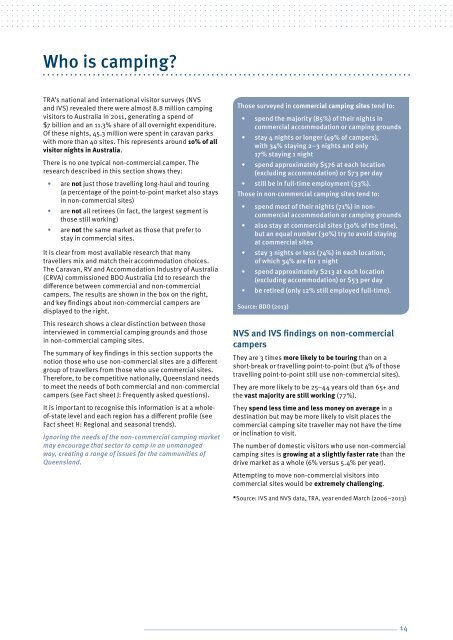qdts-camping-options-toolkit
qdts-camping-options-toolkit
qdts-camping-options-toolkit
Create successful ePaper yourself
Turn your PDF publications into a flip-book with our unique Google optimized e-Paper software.
Who is <strong>camping</strong>?<br />
TRA’s national and international visitor surveys (NVS<br />
and IVS) revealed there were almost 8.8 million <strong>camping</strong><br />
visitors to Australia in 2011, generating a spend of<br />
$7 billion and an 11.3% share of all overnight expenditure.<br />
Of these nights, 45.3 million were spent in caravan parks<br />
with more than 40 sites. This represents around 10% of all<br />
visitor nights in Australia.<br />
There is no one typical non-commercial camper. The<br />
research described in this section shows they:<br />
• are not just those travelling long-haul and touring<br />
(a percentage of the point-to-point market also stays<br />
in non-commercial sites)<br />
• are not all retirees (in fact, the largest segment is<br />
those still working)<br />
• are not the same market as those that prefer to<br />
stay in commercial sites.<br />
It is clear from most available research that many<br />
travellers mix and match their accommodation choices.<br />
The Caravan, RV and Accommodation Industry of Australia<br />
(CRVA) commissioned BDO Australia Ltd to research the<br />
difference between commercial and non-commercial<br />
campers. The results are shown in the box on the right,<br />
and key findings about non-commercial campers are<br />
displayed to the right.<br />
This research shows a clear distinction between those<br />
interviewed in commercial <strong>camping</strong> grounds and those<br />
in non-commercial <strong>camping</strong> sites.<br />
The summary of key findings in this section supports the<br />
notion those who use non-commercial sites are a different<br />
group of travellers from those who use commercial sites.<br />
Therefore, to be competitive nationally, Queensland needs<br />
to meet the needs of both commercial and non-commercial<br />
campers (see Fact sheet J: Frequently asked questions).<br />
It is important to recognise this information is at a wholeof-state<br />
level and each region has a different profile (see<br />
Fact sheet H: Regional and seasonal trends).<br />
Ignoring the needs of the non-commercial <strong>camping</strong> market<br />
may encourage that sector to camp in an unmanaged<br />
way, creating a range of issues for the communities of<br />
Queensland.<br />
Those surveyed in commercial <strong>camping</strong> sites tend to:<br />
• spend the majority (85%) of their nights in<br />
commercial accommodation or <strong>camping</strong> grounds<br />
• stay 4 nights or longer (49% of campers),<br />
with 34% staying 2–3 nights and only<br />
17% staying 1 night<br />
• spend approximately $576 at each location<br />
(excluding accommodation) or $73 per day<br />
• still be in full-time employment (33%).<br />
Those in non-commercial <strong>camping</strong> sites tend to:<br />
• spend most of their nights (71%) in noncommercial<br />
accommodation or <strong>camping</strong> grounds<br />
• also stay at commercial sites (30% of the time),<br />
but an equal number (30%) try to avoid staying<br />
at commercial sites<br />
• stay 3 nights or less (74%) in each location,<br />
of which 34% are for 1 night<br />
• spend approximately $213 at each location<br />
(excluding accommodation) or $53 per day<br />
• be retired (only 12% still employed full-time).<br />
Source: BDO (2013)<br />
NVS and IVS findings on non-commercial<br />
campers<br />
They are 3 times more likely to be touring than on a<br />
short-break or travelling point-to-point (but 4% of those<br />
travelling point-to-point still use non-commercial sites).<br />
They are more likely to be 25–44 years old than 65+ and<br />
the vast majority are still working (77%).<br />
They spend less time and less money on average in a<br />
destination but may be more likely to visit places the<br />
commercial <strong>camping</strong> site traveller may not have the time<br />
or inclination to visit.<br />
The number of domestic visitors who use non-commercial<br />
<strong>camping</strong> sites is growing at a slightly faster rate than the<br />
drive market as a whole (6% versus 5.4% per year).<br />
Attempting to move non-commercial visitors into<br />
commercial sites would be extremely challenging.<br />
*Source: IVS and NVS data, TRA, year ended March (2006–2013)<br />
14


